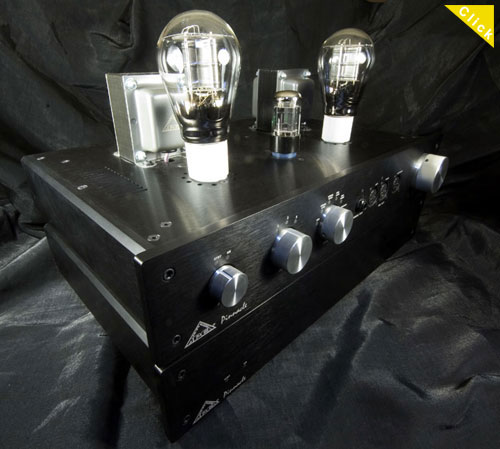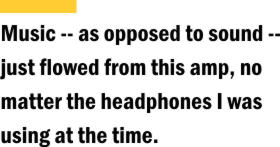Apex • Pinnacle Headphone Amplifier/Preamplifier
was talking to Todd Green -- aka, Todd the Vinyl Junkie -- about why a man whose identity is seemingly devoted to analog playback would decide to manufacture and market a product like the Apex Pinnacle. The explanation was straightforward. For nearly 20 years, Todd was employed in the headphone industry; he worked for one of the biggest high-end headphone retailers, HeadRoom. So he was fully grounded in the personal-listening realm, but he was never quite satisfied with what was available in terms of headphone amplifiers. Thus, in partnership with Pete Millett, who designed some of HeadRoom's amps, Todd brought the Pinnacle to market in order to offer a headphone amp -- and stereo preamp -- that did everything he wanted.
I asked Todd why he and Pete decided to go the tube route with the Pinnacle. "Pete is a tube specialist and my personal preference is for tubes, so it was a natural fit to make the Pinnacle a tube amp." The Pinnacle is a two-box affair. One of the chassis is for the transformers and the other for the control circuits and tubes, the two connected by an umbilical. Why separate chassis? To keep the power supply isolated from the signal path. There is solid evidence that removing the power supply from the vicinity of the signal path improves performance by keeping noise that otherwise might contaminate the sound as low as possible. The power-supply chassis houses separate transformers for high- and low-voltage supplies, so each section has its own dedicated power source, which only improves the Pinnacle’s sonic performance. The Pinnacle is a two-stage, single-ended, transformer-coupled design with both single-ended and true-balanced inputs and outputs. It uses a single 6SN7 driver tube and a pair of large Sophia PX4 output tubes standing proud out of the top of the control chassis. The design is such that the tubes operate in a way that provides some cancellation of even-order distortion between the stages. The Pinnacle has an input impedance of 50k ohms and an output impedance in its Low setting of 12 ohms and in its High setting of 45 ohms. As for frequency response, Todd’s memory is that the Pinnacle is down 3dB at 15Hz and 50kHz. I would like there to be at least one more input -- the reviewer in me can never have enough inputs -- but the three true-balanced and unbalanced ones that are available should be more than enough for most systems. And the couch potato in me misses remote control, especially when the Pinnacle is used solely as a line-stage preamp. The front panel has the input selector and the knobs for volume and the headphone output in three formats: single ended, single balanced, and dual balanced. Around back are the three pairs of inputs, the single-ended and balanced outputs, and the connection for the power-supply umbilical. To aid in hearing what heights the Pinnacle could reach, Todd sent along a number of top-of-the-line headphones, including Beyerdynamic Tesla T1s, Grado PS1000s, and Sennheiser HD 800s, all with diverse terminations, so I was able to not only discover how each sounded but discern the benefits of each connection type. I enjoyed the surprising neutrality of the Grados, the precise yet somewhat closed-in sound of the Beyerdynamics, and the smooth but dark sound of the Sennheisers. However, most of my listening time was spent with AKG K-701s, which are my personal reference headphones, and Audez’e LCD-2s, which I had in for review. Both were terminated for single-ended connection only. s with every piece of audio electronics, the Pinnacle has its own sonic signature. That’s unavoidable, but as is usually the case, the better the product, the less pronounced that signature is. Perhaps this is what led me to a conclusion after only a handful of hours of listening: the Pinnacle was by a wide margin the finest headphone amp I’d ever heard. It was also the most expensive, and while cost doesn’t always equal performance, in this case it certainly did.
The Pinnacle did a wonderful job of reproducing the complex personality of an electric hollow-body guitar -- with all of the sonic nuances intact. One of my favorite albums featuring this instrument is Herb Ellis and Joe Pass's Seven, Come Eleven [Concord 1015-6]. The contrast between Ellis and Pass has never been as easily distinguished as with the Pinnacle, not only their style but also their individual sounds. There was a sense of harmonic and tonal completeness that made it possible to differentiate these two guitarists in purely sonic terms. I could easily distinguish each plucked string of the respective guitars and how the strings excited the guitar bodies to create their own unique imprints. The Pinnacle allowed me to feel less like I was listening to recorded music and more like I was plugged into the same board as the recording engineer. The ability to unearth the differences between mastering jobs of the same music was also possible with the Pinnacle, indicating that one of its strengths was resolving huge amounts of musical information. I bought the new Japanese SHM-SACD On Top of the World [Universal International UIGY 9036/7], a sampler disc that comes packaged with a standard SACD of the same music, so you can decide for yourself whether SHM-SACDs are worth their premium prices. The Sonny Rollins cut "St. Thomas" was to my ears clean, clear and precise, if a bit laid-back and slightly soft-sounding. The drums and bass on the regular SACD sounded heftier, but the sax wasn't as vivid. The SHM-SACD made the sax sound like a brass-and-reed instrument with in-the-room real -- or should I say, "in my head" real -- presence. I could hear Rollins' breath vibrate the reed and seemingly how the air followed the contours of the saxophone. Thus, dredging up micro detail was a thing of ease for the Pinnacle, even with my trusty AKG K-701s. The song "Santa Anna Winds" from Tom Russell’s Blood and Candle Smoke [Shout CD 826663-11471] opens with a softly strummed and plucked acoustic guitar. Through the Pinnacle, that guitar displayed such gorgeous tone and timbre that I closed my eyes and imagined I was in the presence of the real thing -- disbelief thoroughly suspended. There was a tangible sense of fingers brushing across or picking the individual strings and those strings making the body of the guitar vibrate. This was as good as I’ve ever heard my K-701s sound. The Pinnacle was a marvel with well-recorded discs, pushing further back the boundaries of high-resolution digital sound. One of the best-sounding discs I’ve heard lately is the 24-bit/96kHz DVD-A burn of Markus Schwartz & Lakou Brooklyn’s Equinox [SoundKeeper Recordings SR4002]. The clarity and tonal structure of each instrument, and the sense of space between them, were truly amazing. I was especially taken with how the Pinnacle reproduced the bass and percussion instruments. There was a snap to the sound of stick or hand hitting the drum head that was uncannily realistic. Comparing the CD version to the DVD-A showed, once again, how well the Pinnacle revealed subtle detail, such as that snap of the drum head, the brassy blat of the trumpet, and the sense of space that the DVD-A added to the sonic presentation over the CD. Keeping the tempo and pace of the music flowing was another of the Pinnacle’s strong points. Adam Fischer’s version of Mozart’s Symphony No.25 [DeCapo 6.220542] -- one of my favorites of Mozart’s symphonic repertoire -- provided a lesson in proper pacing. If this piece is played too slowly, the dredging pace robs the music of its essential jauntiness and excitement. Played too fast and it loses a sense of emotional involvement. And if any piece of equipment meddles with the tempo, it can ruin the presentation. It’s a fine tightrope to walk, for both conductor and audio system. Fischer and the Pinnacle nailed it, preserving all the emotion and feeling Mozart wrote into this piece. The Pinnacle remained resolute, never thickening or thinning the musical ebb and flow in any way.
If I had to pick nits with the Pinnacle, they would be at the very extremes of sonic spectrum. As with most all-tube products, the Pinnacle's bass doesn’t go quite as deep with quite as much authority as that of certain solid-state contenders, nor does the treble sparkle with quite the shimmer. On the other hand, those solid-state amps don’t come close to reproducing the balance of the musical range as purely and effortlessly as the Pinnacle does with absolutely no sense of strain. From the upper bass through the all-important midrange on to the treble, the Pinnacle was as fine a reproducer of music as I’ve ever heard. As I mentioned early on, the Pinnacle is also a line-stage preamplifier, and I also used it this way. It offered a full, rich, slightly forward but totally involving sound. That slight forwardness can push some music into your lap, but the detail and precise placement of instruments were outstanding for a line-stage preamp. There was plenty of gain -- especially when I used the Pinnacle balanced. In fact, there was perhaps too much, as I wasn’t able to rotate the volume knob past the ten o’clock position without blasting myself out of the room. But even at such an excessive volume level, the Pinnacle never lost its composure. The music just got louder and displayed no sense of strain. In terms of comparisons, my Original Electronics Master Headphone amp ($200), a budget-priced unit offering very good value, provided absolutely no competition. The Pinnacle wiped the floor clean with it. There were essentially no ways in which the Master was master. The Pinnacle just made music sound far more alive and real than the Master could ever hope to. The Pinnacle also allowed different headphones to strut their stuff instead of overlaying each with colorations. The Pinnacle was far and away more versatile, offering all the different options for connecting headphones -- the Master is single-ended only -- as well as preamp functionality. f you’re looking for a headphone amp that will never restrict you in both your choice of headphones and connections while making the music you love come alive, then the Apex Pinnacle is made for you. Buying the Pinnacle because it's a great headphone amp or a great preamp would not be an act of spending money unwisely. But combine this functionality and, even at its rather hefty price, the Pinnacle represents good value. The Apex Pinnacle is a product that not only meets but
exceeds expectations -- my expectations, for sure. If you have the scratch, you’ll
likely not be disappointed. If you hear it, you'll likely not want to return it.
|


 "Smooth,"
"silky," "unforced," and "natural" were words that appeared
again and again in my notes as I listened with the Pinnacle. Music -- as opposed to sound
-- just flowed from this amp, no matter the headphones I was using at the time. Each set
of headphones displayed its own sonic strengths and weaknesses with little overt
contribution from the Pinnacle. About the only bona fide coloration I can lay at the feet
of the Pinnacle was a very slight added warmth that I attribute to its tubes. If I
have a choice between a little added warmth or coldness and sterility, I’ll take
warmth any day, because that is more in line with the way live music sounds.
"Smooth,"
"silky," "unforced," and "natural" were words that appeared
again and again in my notes as I listened with the Pinnacle. Music -- as opposed to sound
-- just flowed from this amp, no matter the headphones I was using at the time. Each set
of headphones displayed its own sonic strengths and weaknesses with little overt
contribution from the Pinnacle. About the only bona fide coloration I can lay at the feet
of the Pinnacle was a very slight added warmth that I attribute to its tubes. If I
have a choice between a little added warmth or coldness and sterility, I’ll take
warmth any day, because that is more in line with the way live music sounds. Comparing the balanced and
unbalanced headphone connections was illuminating. Using the balanced connections with the
Audez’e headphones was a definite sonic step up over the single-ended connections.
The sound was cleaner, purer, and quieter, allowing the music to seem that much closer to
the real thing, as though a previously imperceptible layer of haze had been removed. If
you buy a Pinnacle, you should most definitely have your reference headphones terminated
for balanced connection. Not doing so is like buying a Ferrari to drive to the corner
grocery store -- such a waste of high performance.
Comparing the balanced and
unbalanced headphone connections was illuminating. Using the balanced connections with the
Audez’e headphones was a definite sonic step up over the single-ended connections.
The sound was cleaner, purer, and quieter, allowing the music to seem that much closer to
the real thing, as though a previously imperceptible layer of haze had been removed. If
you buy a Pinnacle, you should most definitely have your reference headphones terminated
for balanced connection. Not doing so is like buying a Ferrari to drive to the corner
grocery store -- such a waste of high performance.